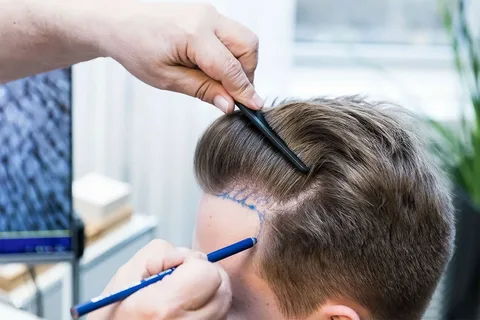Hair transplant operation is a cosmetic procedure applied to men and women who have significant hair loss, hair thinning, or bald spots that no longer grow hair. The procedure can enhance your appearance and self-confidence by using your existing hair.
DHT (Dihydrotestosterone) is a natural metabolite of the human body and is the main cause of hair loss in both male and female pattern baldness. In male pattern baldness, the hair typically grows only in a horseshoe shape around the head. Female pattern baldness is characterized by widespread thinning of hair on the entire scalp, although some women have hair loss that mimics male pattern baldness.
Who is a good candidate for a hair transplantation?
All hair transplantation techniques use your existing hair from the donor areas. The hair below the ear level in men is genetically programmed not to fall out. These hairs can be planted on the front hairline and will never fall out.
Most women have female pattern baldness and do not have donor sites available for transplantation. If thinned hair pieces and accompanying roots are transplanted from one area, they will not be stable enough for their growth.
Due to the widespread effect of DHT on female hair, a very small percentage of women are good candidates for hair transplantation. This small group includes:
- Women who experience hair loss due to mechanical or traction alopecia (non-hormonal)
- Women who have had previous cosmetic or plastic surgery and are concerned about hair loss around the incision sites
- Women with a distinctive pattern of baldness similar to male pattern baldness.
- Women who experience hair loss due to trauma, including burn victims, scars from accidents, and chemical burns
- Women with alopecia marginalis, a condition very similar to traction alopecia
How is a hair transplantation performed?
Hair transplant operation is typically performed as an outpatient procedure with local anesthesia or local anesthesia and sedation. There are several different hair graft methods, and the actual process usually includes:
- Selecting and removing hair from the donor area: For most people, the back of the head is the most suitable area. Your specific level of hair loss is critical. If you do not have enough naturally growing hair on your head, you may not be an ideal candidate for a hair transplant operation. Collecting hair from the donor area involves removing small pieces of scalp grafts from the donor area and replanting them in a bald or thinned area.
- Closure of the donor area: After a suitable-sized donor hair strip is taken, the incision is sutured. Typically, these stitches are removed about 10 days after surgery, leaving a small scar behind that can be hidden by your hair.
- Transplantation of hair grafts: After the donor strip is removed, tiny hair grafts are prepared for hair transplant surgery on your bald areas. Most of the time, each of the hair grafts in the anterior hairline contains 1-3 hairs. As the grafts are planted further back from your hairline, the number of hairs per graft will increase.
Just before the hair transplant operation, the “donor area” is cut short so that the hair grafts can be easily accessed and removed. Before the grafts are taken, your doctor will inject epinephrine with a local anesthetic to minimize bleeding. Donor site holes can be closed with stitches for staple grafts, with a single suture closing each staple site; for other types of grafts, a small, flat scar will form. The seams are often hidden by the surrounding hair. To maintain healthy circulation in the scalp, your doctor will place the grafts so that each graft is surrounded by healthy skin. In the next sessions, the remaining gaps will be filled with additional grafts. After the hair transplant operation is completed, your scalp will be cleaned and covered with gauze. You may need to wear a pressure bandage for a day or two to aid healing.
How is life after hair transplantation?
Hair transplant operation does not produce new hair all of a sudden. In most cases, the hair falls out of the grafts immediately after hair transplantation and does not grow back for about three months. The donor sites heal slowly, leaving a slight scar, but this is hidden by the hair growing around the area. In general, several surgical sessions may be required to achieve satisfactory fullness, and a recovery interval of several months is usually recommended between each session. The amount of coverage you need depends on the color and texture of your hair and the area to be covered. Coarse, gray, or light-colored hair provides better coverage than fine, dark hair.
You can always consult experienced plastic surgeon Dr. Umut Suadiye to learn more about your personalized aesthetic needs.
References:
Cleveland Clinic, Hair Replacement Surgery/Hair Transplant. https://my.clevelandclinic.org/cosmetic-plastic-surgery/procedures/hair-loss. Last Accessed: May 2023.

